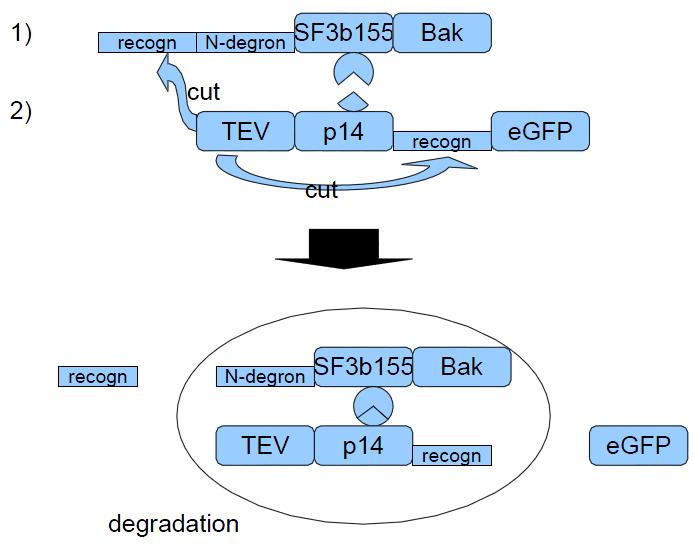TEVdegron-System
The TEVdegron-System uses and combines several proteins with different properties to select the incorporation of a plasmid by apoptosis. We need two DNA constructs and one of them (construct 1) should be integrated in the cell's DNA.
Construct 1
Construct 1 contains the following parts in this order:
CMV-promoter for the hygromycin resistance, hygromycin resistance, tetracyclin-inducible promoter, TEV-recognition site, N-degron, SF3b155, human bak.

To check the integration of this construct into cellular DNA we need the hygromycin resistance which can be read-off thanks to the CMV-promoter. The TEV-recognition site will be cut by the TEV-protease which is part of construct 2. Due to the scission of TEV-recognition site the N-terminus of N-degron is free which is a signal for the degeneration of this protein. SF3b155 is a protein interacting with p14 from construct 2. This interaction should make sure that the TEV-protease of construct 2 will really "find" the recognition site. The human bak is a apoptosis triggering membrane protein.
Construct 2
Construct 2 is composed of CMV-promoter, TEV-protease, p14, TEV-recognition site, eGFP and a double stop codon.

The CMV-promoter is to read off construct 2. The task of TEV-protease is to cut TEV-recognition sites, especially the one ahead of N-degron to signal protein degradation. p14 is interacting with SF3b155 and so increases the rate of finding the TEV-recognition site by the TEV-proteases. eGFP is our example of a gene of interest which can be verified by green flourescence.
Selection
So you have a cellline which has integrated construct 1 and transfect it with a plasmid containing construct 2. Then there are two possibilities:
a) the plasmid has not been incorporated
b) the plasmid has been incorporated
which leads to the following consequences.
Case a) the plasmid has not been incorporated
We induce the tet-on promoter and so construct 1 will be translated into protein. The bak-part will integrate into mitochondrial membrane and as a result will induce apoptosis.
Case b) the plasmid has been incorporated
Construct 2 will be read off and and already existing when tet-on promoter will be induced to create construct 1 as protein. Therefore TEV proteases will instantly seperate eGFP from the remain of the protein an will free the N-terminus of N-degron. This will cause the degradation of the whole protein complex - including bak. So only the gene of interest and the whole cell will "survive".

So you can see that cells that incorporated the plasmid will survive.
|


![]()
![]()







![]()
 "
"




